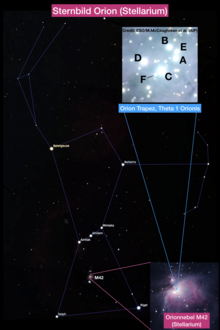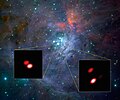Trapezoid (astronomy)
The trapezoid (also θ 1 -Orionis ) is a group of stars in the center of the Orion Nebula . It consists of numerous components of different lightness. It owes its name to the fact that its four brightest components form roughly a trapezoid (θ 1 A – D). In the WDS it has the number 05353-0523, in the CCDM the number 05353-0524.
The weaker components are ( θ 1 E-H ), the majority of which are physical multiple stars. In fact, the trapezoid is the brightest component of a very densely packed open star cluster , the so-called trapezium cluster. The trapezoid itself has a projected diameter of approximately 10,000 AU in the center of the Orion Nebula, which is approximately 1,350 light years from Earth.
The trapezoid can be observed with the naked eye as a single bright star ( apparent visual brightness V = 4.65). Good binoculars are required to observe all four bright trapezoidal stars. The Orion Nebula itself can also be observed with the naked eye as a spot ( apparent visual brightness V = 4).
If it weren't for the trapezoid, we wouldn't see the Orion Nebula at all. The heavy trapezoidal stars release a lot of ultraviolet radiation, which ionizes the hydrogen atoms in the nebula. The resulting protons and electrons can recombine to form excited hydrogen. This often happens in a 2-step process. First the electron is captured to the third lowest energy level, and from there it falls to the second lowest energy level. Red light with a wavelength of 656 nm is emitted, the famous Balmer H-alpha line. Because of this effect, the Orion Nebula is also known as the Emission Nebula.
Astronomical meaning
The trapezoidal stars were formed about 1 to 2.5 million years ago directly from the material of the Orion Nebula, which is about 24 light years in diameter , and now stimulate it to glow through ionization . They drive the gas and dust clouds apart by their stellar wind and create a spheroid cavity, the interior of which is illuminated by the ionization radiation and thus forms the part of the Orion Nebula that is clearly visible from Earth.
The stars in the trapezoid have masses up to about 45 solar masses . The Trapezium Cluster is a younger subgroup of the Orion Nebula Cluster (ONC), which is about 20 light years in diameter and consists of about 3500 stars that are less than 10 light years apart from the Trapezoidal stars.
The four light components have the following identifiers:
| Bayer | WDS comp. | WDS subcomp. | CCDM comp. | HD | Right ascension (degrees) | declination | Spectral class | Visual brightness | Number of subcomponents |
|---|---|---|---|---|---|---|---|---|---|
| θ 1 Ori A | A. | Aa, Ab | B. | 37020 | 83.815938 | −5.387315 | B0V | 6.7 | at least 2 |
| θ 1 Ori B | B. | Ba, Bb, Bc, Bd, Be | D. | 37021 | 83.817133 | −5.385247 | B1V | 8.0 | at least 6 |
| θ 1 Ori C | C. | Ca, Cb | A. | 37022 | 83.818599 | −5.389680 | O7Vp | 5.1 | 2 |
| θ 1 Ori D | D. | Da, Db, Dc | C. | 37023 | 83.821635 | −5,387657 | B1.5V | 6.7 | 3 |
θ 1 Ori B is a hierarchical multiple system, in which at least six stars orbit each other as follows: A close eclipsed pair B 1 and B 5 is orbited by B 6 at a distance of about 5 AU. The component B 4 and another close pair B 2 and B 3 are located at a projected distance of approximately 400 AU . Scheme: . The sixth component was only discovered in 2018 and is therefore not in the WDS catalog.
{ {B1 B5} B6 } B4 {B2 B3}
Discovery story
In 1610, the French astronomer Nicolas Claude Fabri de Peiresc aimed his telescope at this region. Today he is considered to be the discoverer of the diffuse appearance of the Orion Nebula.
In contrast, Galileo Galilei is considered to have discovered three of the four trapezoidal stars inside the Orion Nebula (M42). He wrote down his observations in his notebook. He saw the three lighter components A, C and D of the four trapezoidal stars. He noted that components A and D are approximately equally bright and are at the same distance from component C. Furthermore, components A and D are so close to C that they practically touch them. Theta 1 Orionis was the first star to be resolved into several components with a telescope. A sketch from Galileo's work can be found in Christopher Graney's publication On the Accuracy of Galileo's Observations .
In 1656 the Dutch astronomer Christiaan Huygens observed the Orion Nebula. Based on his drawings, Christiaan Huygens was considered to be the discoverer of the Orion Nebula and the trapezoid until the 19th century. However, like Galileo Galilei before, he only saw three of the actual trapezoidal stars. In 1673, Jean Picard discovered a fourth star inside. Christiaan Huygens also noticed this star in 1684 and later called this group of four "Trapezium".
identification
The trapezoid is easily recognizable by its characteristic shape that gives it its name - formed by four relatively bright stars. These are usually identified as A, B, C, and D in order of increasing right ascension . The brightest of the four stars is C or Theta1 Orionis C , with an apparent magnitude of 5.13. Both A and B were identified as coverage variables .
Infrared images of the trapezoidal pile are able to penetrate the surrounding dust clouds. This will make more stars visible. Many of the stars in the trapezoid cluster have so-called protoplanetary disks made of gas and dust.
Web links
- Theta Orionis, the trapezoid in the Orion Nebula , information compiled by JS Schlimmer
- Trapezium: At the Heart of Orion , Astronomy Picture of the Day, August 2018
- Flight in the Orion Nebula Video animation of the discovery of a double star with the GRAVITY instrument (2016)
- Camera Orion , Astronomy Picture of the Day, March 2018
Individual evidence
- ↑ The SIMBAD database has eight components
- ↑ a b Simón-Díaz, S. et al. (2006) , Detailed spectroscopic analysis of the Trapezium cluster stars inside the Orion nebula
- ↑ Since Rio et al. (2014) , The Structure, Dynamics, and Star Formation Rate of the Orion Nebula Cluster
- ↑ Lynne A. Hillenbrand (1997) , On the stellar population and star-forming history of the Orion Nebula Cluster
- ↑ GRAVITY Collaboration et al. (2018) , Multiple Star Systems in the Orion Nebula
- ↑ complete documentation on Multiple Star Systems in the Orion Nebula
- ↑ WDS
- ↑ Harald Siebert (2010): The discovery of the Orion Nebula. Historical records from 1610 re-viewed. In: Stars and Space. No. 11, pp. 32-42.
- ↑ Harald Siebert (2009): Peiresc's nebula in the constellation Orion — a new textual basis for the story of M42 . In: Annals of Science, 66: 2, 231-246, doi: 10.1080 / 00033790801968857
- ↑ Guillaume Bigourdan (1916): La de'couverte de la ne'buleuse d'Orion par Peiresc . In: Comptes rendus de l'Académie des Sciences . Volume 162, pp. 489-490
- ^ C. Graney (2007): On the Accuracy of Galileo's Observations . In: Baltic Astronomy, Vol. 16, p. 443-449, bibcode : 2007BaltA..16..443G
- ↑ GRAVITY discovers that one of the stars in the Orion Trapeze is a binary star . Retrieved September 19, 2016.






